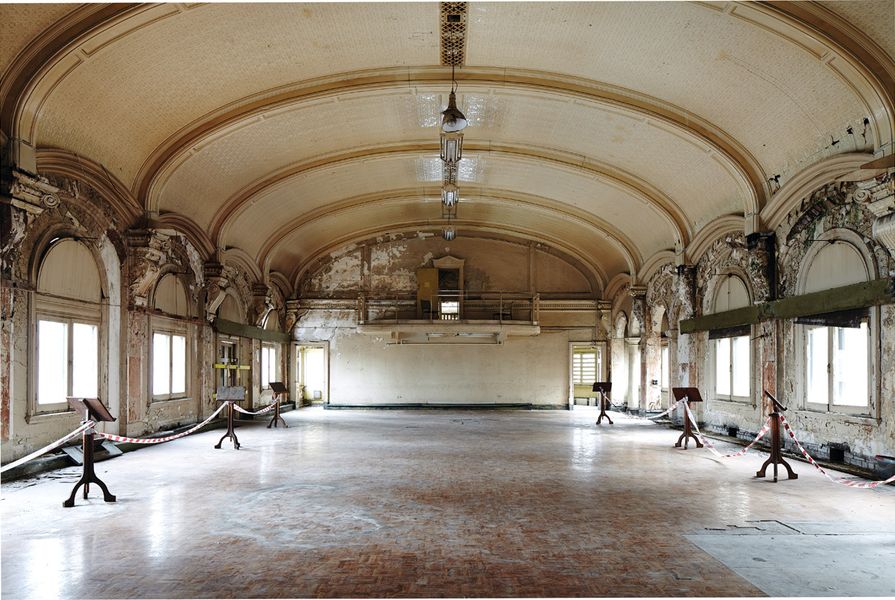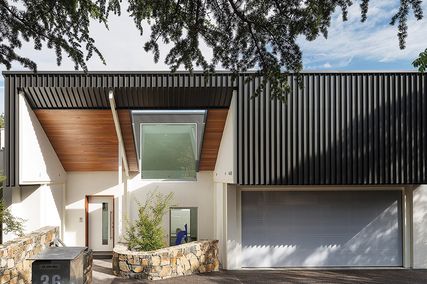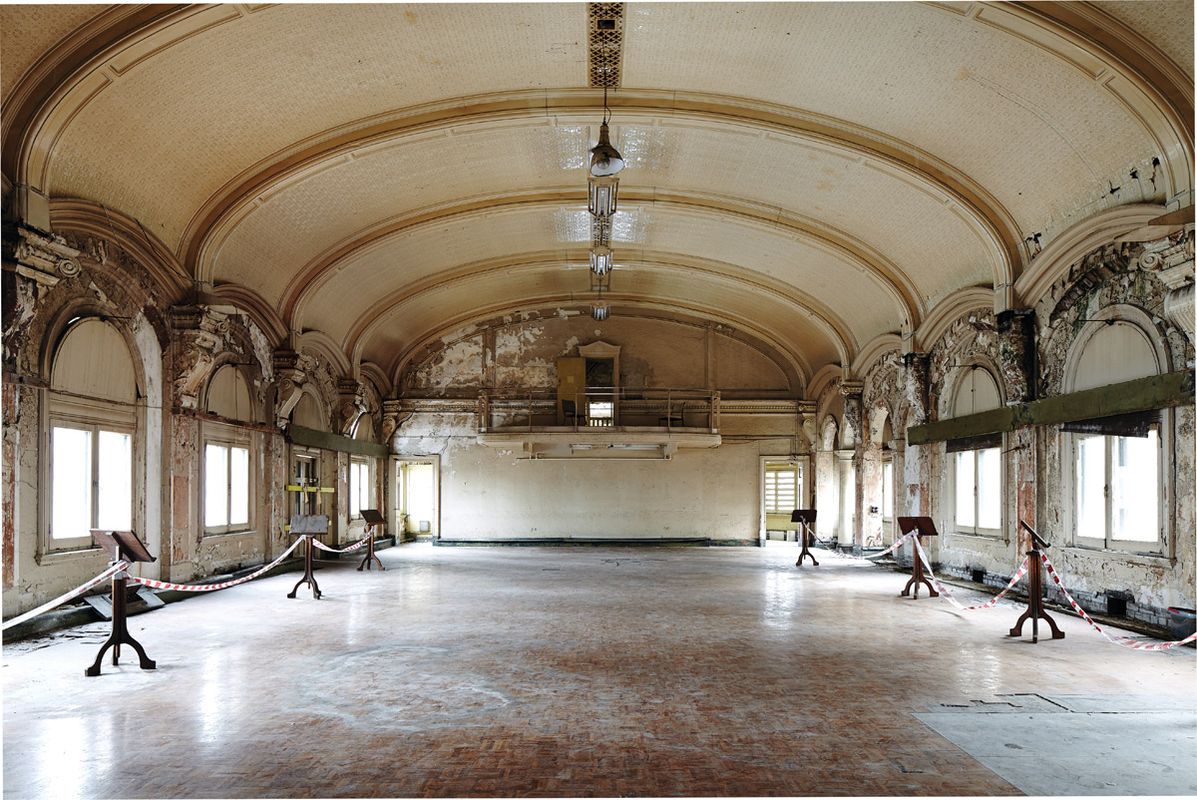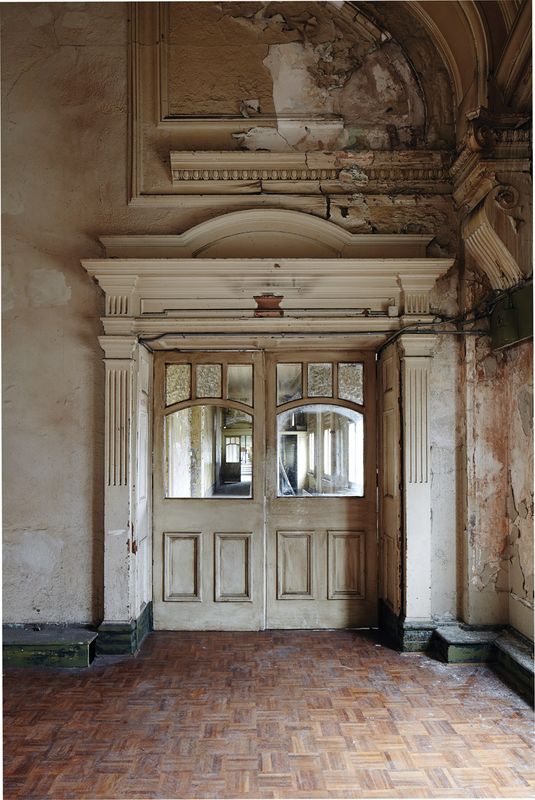Flinders Street Station ballroom is in decay, shut off from the eastern half of the station’s third floor by padlocked metal gates. Inside, water is leaking from the roof and the plasterwork is crumbling away. Is this a bad thing? It’s certainly great for photography. The space appears like a time capsule, a visual essay in what happens when you stop spending money and energy on maintenance, and when the idea of renovation or rejuvenation falls off the agenda.
Why? Don’t we need ballrooms anymore? Or is it the Victorian Heritage Register’s database listing that hinders a cheaper, more utilitarian refurbishment? Looking at the various modifications and intrusions into the early-twentieth-century design, it is obvious that there were some periods where its preciousness as a culturally significant place was not appreciated. My favourite example of callous functionalism is above the entry door, where modern electrical cabling bursts forth from the plaster decorations, extending tendrils into the space like a rampant vine.
The whole Flinders Street Station building has been slated for demolition on many occasions. It was nearly replaced by Gas and Fuel Corporation of Victoria buildings in the early 1960s, which ended up being built on the site now occupied by Federation Square. Those towers only lasted thirty years, not quite long enough to generate nostalgia. The station has been earmarked for improvement many times, but for one reason or another nothing much has happened. The latest design competition, launched in late 2011, will probably turn out to be hot air too – no-one is making any commitments to actually build the winning design, which was announced in August 2013. But the government does have two years to think about it.
Despite the decay, the architecture of the ballroom still speaks volumes of what was once a hub of social and cultural activity.
Image: Alicia Taylor
In the meantime, the western end of the station’s third level remains quarantined like a festering wound, its steel-gate-tourniquet in place. And like a gangrenous limb, it is dangerous to human health – on my tour I was not allowed to walk near the edges of the space lest a part of the decoration fall on my head, or I trip on a patch of peeling parquetry floor.
Designed in 1899 and completed by 1910, the space we know as the ballroom began life as the Victorian Railways Institute lecture hall. The entire third floor was added to the design during construction to accommodate this newly formed association. The association’s role was the betterment of railway staff, looking after their physical and mental welfare. They offered education classes at night so employees could improve their chances of promotion within the Victorian Railways organization. A lending library delivered books to members by train. As well as the lecture hall, the on-site facilities included a billiard room, a table tennis room, a private gymnasium complete with a boxing ring, and a running track on the roof. All of this was behind the anonymous and repetitive facade described as “French Renaissance in a free manner” (from the Victorian Heritage Register, which quotes the architects James Fawcett and H. P. C. Ashworth).
The old private gymnasium of the Victorian Railway Institute on level three.
Image: Alicia Taylor
For me it conjures up a moment in Rem Koolhaas’s book Delirious New York where he discusses the men-only Downtown Athletic Club, which had different functions on different floors, and where it was possible to be “eating oysters with boxing gloves, naked, on the ninth floor,” behind the facade of an ordinary 1930s skyscraper. The facilities in Flinders Street Station are not that surreal, but the gymnasium and the billiards room were men-only spaces …
The gymnasium is lit in soft pink every few seconds by an electronic billboard across from Flinders Street Station. This space is not romantic, it’s spooky – chains and Roman rings hang from the ceiling like meat hooks. The harsh tone is reinforced by a message on the wall that reads “DO NOT DAMAGE THE BAG – USE ONLY FISTS,” scrawled in black paint. Was this a witty contemporary piece of graffiti, conjuring up the mood of the boxing and wrestling that once went on in the space?
In 2012 a group of artists had worked in the vacant spaces of the station. The gymnasium was allocated to artist Robbie Rowlands, who recreated the boxing ring and power-sawed a series of cuts into some disused office furniture in the space, his dissections transforming their square forms into spine-like curves. But it was not Rowlands who wrote on the wall. The message dates back to the 1960s when the space first began to become run-down and neglected, and was used by interlopers rather than official members of the Victorian Railways Institute.
Archival photograph of Flinders Street Station.
Image: Courtesy Major Projects Victoria
An excellent website on the history of the station, flindersstreetstation.com.au, records the stories of people who knew it in its heyday. The stories reveal the allure of dances at the station ballroom – the place would shut down before midnight so that everyone could catch the train home. The mezzanine bandstand dates back to the 1950s, when the ballroom was so popular they had to make extra space. Another story tells us that the public function of the hall ceased in 1985 for the impending “reconstruction” of Flinders Street Station as announced by the then Ministry of Transport – another plan that didn’t eventuate.
The station will be getting an overhaul of some kind soon, to cope with “the expected massive increase in public transport use over the next five, ten, twenty years,” says Victorian Premier Denis Napthine as reported in the Herald Sun. Today, around 100,000 people use the station every day. It was claimed in 1926 to be the world’s busiest station. A children’s nursery was installed on the second floor in 1933 so that mothers could go shopping in the city unencumbered. You could call Flinders Street Station a transit-oriented development, a multifunctional activity centre that encourages walking, merely designed in 1899. It seems we have something to learn from the time when rail was king.
Source
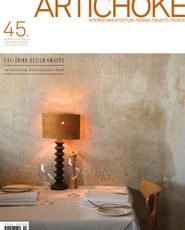
Discussion
Published online: 12 Mar 2014
Words:
Tobias Horrocks
Images:
Alicia Taylor,
Courtesy Major Projects Victoria
Issue
Artichoke, December 2013

